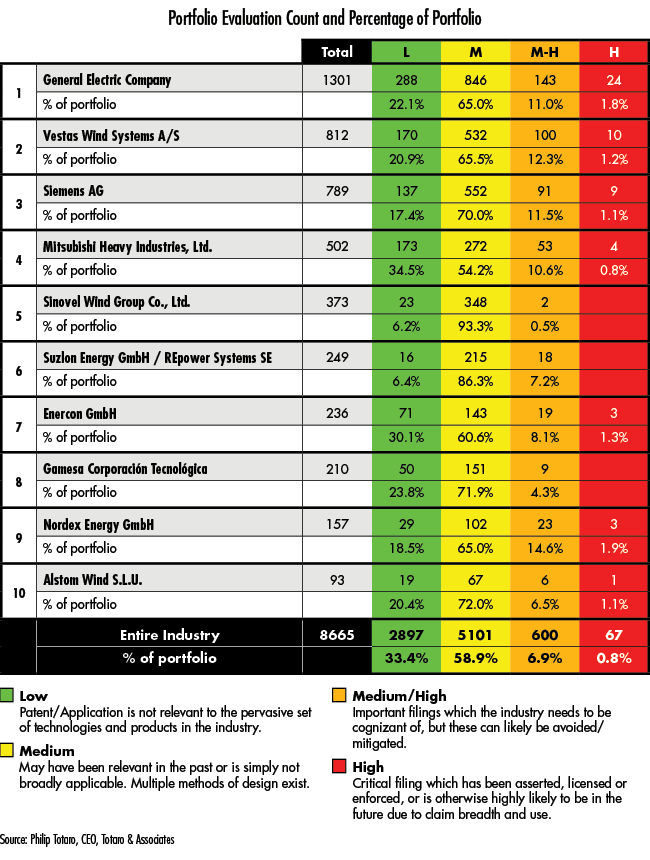 New research shows that the U.S. has the greatest number of patent filings on wind turbine technology, and domestic companies have collectively spent over $143 million on intellectual property (IP) protection with more than 7,200 individual patent filings. Europe is second at $112 million with over 5,100 filings and China third at $44 million with over 3,700 filings.
New research shows that the U.S. has the greatest number of patent filings on wind turbine technology, and domestic companies have collectively spent over $143 million on intellectual property (IP) protection with more than 7,200 individual patent filings. Europe is second at $112 million with over 5,100 filings and China third at $44 million with over 3,700 filings.
Globally, the entire wind industry has spent $430 million to date on patent protection on more than 32,800 patent filings. Costs are expected to escalate, with $1 billion to be spent by 2020 and $2 billion by 2030. The pace of patent filings has increased dramatically in recent years, with a compound annual growth rate (CAGR) of over 30% in the past five years.
Research indicates that General Electric (GE) leads with 1,300 patent families, and Vestas, Siemens, Mitsubishi and Sinovel round out the top five.
GE holds the largest percentage of all wind-related IP with more than 15% of patent filings. Notably, GE's percentage of patents deemed ‘high risk’ is twice the industry average. High-risk patents are those that are asserted, licensed or enforced, or highly likely due to claim breadth and use. Further, GE's portfolio comprises over 35% of all high-risk patents held by all companies throughout the industry.
Anecdotally, ranking in IP ownership appears to closely coincide with commercial success in the industry. Combined, the top 10 turbine original equipment manufacturers (OEMs) control 54.5% of patent filings. Note that the 2012-2013 filings have not all yet been published because of an 18-month window in which the patents are not made public. Filing count up to 2011 is comprehensive.
Research shows that the majority of filings have occurred in the past decade. Comparison of this trend to turbine capacity additions worldwide is reflective of the shared influence of public policy on technology adoption and the subsequent cost efficiencies enabled by widespread deployment of wind turbines. IP capture will continue to be an important consideration for top-tier companies that are developing and commercializing new products.
The following will be the emerging trends in wind turbine technology and, therefore, patent protection.
Component size and weight reduction – transportation across land and sea of increasingly heavy components
– Advanced materials such as low-cost carbon and hybrid fabrics for blades, graphene-based power electronics and alternatives to rare-earth magnet materials
– Sectional components such as blades and towers
– ‘Self-erecting’ capabilities
– On-site assembly procedures while maintaining component quality/integrity
– Load mitigation tech/controls, especially incorporation of forward-looking capabilities, such as LIDAR as well as model-based controls and anticipatory controls.
Turbine reliability
– Drivetrain/turbine architecture (fewer gearbox stages – move toward medium speed)
– Elimination of gearbox – direct drive
– Gearbox load mitigation utilizing flex-pin architecture
– Simplified electrical component design – solid-state power electronics
Fleet management/O&M
– Deployment of condition-based maintenance solutions (CBMS) with emphasis on the following:
- Calculating component damage accumulation
- Calculating remaining useful component/system life
- Turbine output optimization based on remaining useful life
- Trend analysis of SCADA data
- Predictive maintenance scheduling
– Remote inspection technologies
- Remotely monitored sensor system
- Wireless data transmission technologies
- Optical/video camera-based blade tower inspection
- Tower-climbing inspection "robots"
- Aerial remote controlled vehicles
Performance optimization
– ‘Maximum energy, all the time’
- Optimal energy production regardless of prevailing conditions
- Derate/uprate control capabilities
- Active power curtailment while maintaining wind farm local grid stability
– Site-specific design and assessment tools – modularity of component design and the ability to have multiple options for hub height and rotor size mean more opportunities exist for a common platform architecture to serve a particular wind site regardless of variation in average speed and wind shear.
– Integration of turbine controls with the condition monitoring system (CMS)
– Blade aero/structural performance – flaps, vortex generators, plasma actuators
Grid friendly
– SCADA and power plant controls – ensuring wind parks operate much like conventional energy plants today, where output can be throttled and grid fluctuations can be absorbed, etc.
– Multi-level, medium-voltage converters/electrical system components
– Enhanced low-voltage ride through and VAR support
– Energy storage for time shifting, black start and grid smoothing
– Mitigation of grid harmonics and sub-synchronous inductance
Offshore
– Custom installation vessels and methods
– Load-mitigating foundations – floating, jacket, monopole, suction bucket and gravity base
– Co-generating foundation structures
– To keep reducing the cost of energy, there will need to be enormous research and development (R&D) expenditure to get even a 5% to 10% improvement going forward, due to diminishing returns being reached in turbine capital expenditures.
Another factor that contributes significantly to the commercialization gap are project financiers that do not incentivize the development and introduction of new technologies and products due to the associated technical and commercial risks. This leaves turbine OEMs and key component suppliers to vendor-fund prototypes, form joint ventures, partner with developers/customers or seek external investment. All of those options can be expensive propositions and are likely more suited for the larger industrial conglomerates.

Philip Totaro is CEO at Totaro & Associates, a Santa Barbara, Calif.-based consulting firm. He can be reached at (805) 405-3947 or ptotaro@totaro-associates.com.



